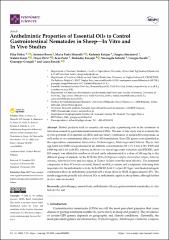Anthelmintic Properties of Essential Oils to Control Gastrointestinal Nematodes in Sheep—In Vitro and In Vivo Studies

View/
Date
2022Author
Štrbac, Filip
Bosco, Antonio
Maurelli, Maria Paola
Ratajac, Radomir
Stojanović, Dragica
Simin, Nataša
Orčić, Dejan
Pušić, Ivan
Krnjajić, Slobodan
Sotiraki, Smaragda
Saralli, Giorgio
Cringoli, Giuseppe
Rinaldi, Laura
Metadata
Show full item recordAbstract
Herbal products such as essential oils may play a promising role in the treatment of
infections caused by gastrointestinal nematodes (GINs). The aim of this study was to evaluate the
in vitro potential of 11 essential oils (EOs) and one binary combination of isolated EO compounds, as
well as the in vivo anthelmintic efficacy of two EO formulations. Four GIN genera were identified in
the coproculture examination: Haemonchus, Trichostrongylus, Teladorsagia and Chabertia. The in vitro
egg hatch test (EHT) was performed at six different concentrations (50, 12.5, 3.125, 0.781, 0.195 and
0.049 mg/mL) for each EO, whereas in the in vivo faecal egg count reduction test (FECRT), each
EO sample was diluted in sunflower oil and orally administrated at a dose of 100 mg/kg to the
different group of animals. In the EHT, the EOs of Origanum vulgare, Foeniculum vulgare, Satureja
montana, Satureja hortensis and two types of Thymus vulgaris were the most effective. The dominant
compounds of these EOs were carvacrol, thymol, anethol, p-cymene and
-terpinene, indicating their
importance for the anthelmintic activity. In the FECRT, both T. vulgaris EO type 1 and linalool:estragole
combination show an anthelmintic potential with a mean effect on FECR of approximately 25%. The
results suggest the possible role of tested EOs as anthelmintic agents in sheep farms, although further
in vivo tests are needed.
